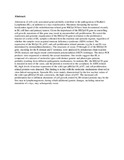| dc.description.abstract | Alterations of cell cycle-associated genes probably contribute to the pathogenesis of Burkitt's Lymphoma (BL), in addition to c-myc translocation. Mutations disrupting the nuclear localization signal of the retinoblastoma-related gene RB2/p130 have been documented recently in BL cell lines and primary tumors. Given the importance of the RB2/p130 gene in controlling cell growth, mutations of this gene may result in uncontrolled cell proliferation. We tested the expression and genomic organization of the RB2/p130 gene in relation to the proliferative features of a series of BL samples collected from the endemic and sporadic regions, regardless of whether the samples were acquired immune deficiency syndrome (AIDS)-related. The expression of the Rb2/p130, p107, and cell proliferation-related proteins (cyclin A and B) was determined by immunohistochemistry. The structures of exons 19 through 22 of the RB2/p130 gene, encoding for the B domain and C terminus, were analyzed by polymerase chain reaction (PCR) analysis and single-strand conformation polymorphism (SSCP) technique. The direct PCR products were sequenced to identify the actual mutations. Our results suggest that BL is composed of a mixture of molecular types with distinct genetic and phenotypic patterns, probably resulting from different pathogenetic mechanisms. In endemic BL, the RB2/p130 gene is mutated in most of the cases, and the protein is restricted to the cytoplasm. In AIDS-related BL, high levels of nuclear expression of the wild-type pRb2/p130, p107, and cell proliferation-related proteins were detected. This finding is in line with the molecular mechanisms observed in virus-linked oncogenesis. Sporadic BLs were mainly characterized by the low nuclear values of the wild-type pRb2/p130 and, conversely, the high values of p107. The increased cell proliferation due to different alterations of cell growth control by Rb-related proteins may be the first step in lymphomagenesis, during which additional genetic changes, including missense mutations of c-myc, may subsequently occur. | en |

